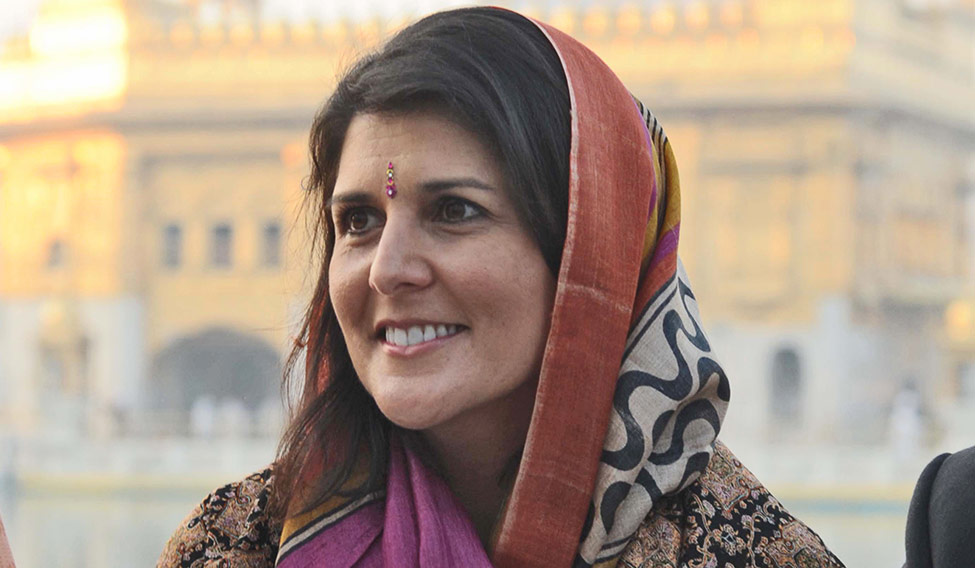In the year Neil Armstrong landed on the moon and took a giant leap for mankind, Ajit Singh Randhawa took a small step for his family by making Bamberg his home, upsetting the neat racial balance of black and white in that small town of 2,500 people in South Carolina. Years later, his daughter Nikki Haley (born Nimrata Randhawa) would take her own leap into history by becoming the first woman minority governor of South Carolina.
On November 23, president-elect Donald Trump named Haley as his choice for the US ambassador to the United Nations, making her the first Indian American to be nominated to a cabinet-rank position in the US. The move assumes all the more significance as Haley has never been the most enthusiastic Trump supporter. She had supported Marco Rubio in the Republican primary race. And, her views on issues like immigration are not in tune with the president-elect. “I am very angry,” was Trump’s response to Haley’s criticism of his immigration policy early last year. So, her elevation to a cabinet-level post is being seen by many as a way to soften his image.
Possibly, it is Trump’s way to add diversity to his team of white boys. But Shalabh Kumar, the billionaire founder of the Republican Hindu Coalition, defended Trump’s move, saying he was a very good judge of character. “She was called for an interview. I knew she would get the job,” said Kumar, who had helped Haley rally the Indian community in South Carolina during the gubernatorial elections. He was also her biggest donor. Kumar said Haley was “brilliant, charismatic, a conservative and a best friend of taxpayers”.
Although Haley’s nomination is a major boost for the Indian American community, as the ambassador to the UN, she could be handicapped by the lack of relevant experience. Her supporters, however, hope that being an Indian American who rose through the ranks, she will be the voice of those who can’t speak up, especially in this administration.
“When Nikki Haley was running for governor for the first time, she had come to [Washington,] DC, for an event that we were co-hosting. It was mainly a non-Indian crowd. What struck me was that she started out by saying that she was the daughter of immigrants and that she talked about how her experience as an immigrant had made a lasting impression on her,” said Sanjay Puri, chairperson of the United States India Political Action Committee. “It was very refreshing to see a political candidate in the very deep south of the US being proud of her ethnic roots,’’ he said.
Haley has defied odds and tamed formidable rivals right from her first brush with electoral politics. In 2004, she chose to contest the South Carolina House of Representatives elections from the 87th district. Her opponent was Larry Koon, a man who called her “little lady’’. Half the voters in the district were his relatives. Koon fought dirty, bringing into play Haley’s ethnicity and background. Yet, it was Haley who emerged winner.
In 2010, when she ran for governor, the contest was no less ugly. But she still found a way to win. Kumar, who was enlisted by her father during the campaign, recollected what Donald Totten, who was Ronald Reagan’s campaign manager, said after listening to Haley’s speech for the first time. “He was impressed. He told me that she was very good and she would go somewhere,” said Kumar.
Haley emerged as a true leader following the 2015 Charleston massacre during her second term as governor. Dylan Roof, a white supremacist, went on a shooting spree in an Afro-American church in Charleston. Nine people, including state senator Clementa Pinckney, who was also the pastor of the congregation, lost their lives in the attack. Haley called the massacre “pure hate” and used the incident to establish a moment of unity. After pictures of Roof with the confederate flag surfaced following the attacks, Haley moved a resolution to remove the flag from the state capitol grounds. “I could not look my kids in the face and justify that flag anymore,’’ she said in an interview, although she had earlier opposed moves to remove the flag from state grounds.
Haley possibly took such a firm stand because fighting prejudices comes naturally to her. Even as her name was doing rounds as a potential Trump cabinet member, photos of her father wearing a turban began circulating on social media, with right-wing polemists like Ann Coulter assailing her Indian roots. It was also a throwback to the past when Haley began her political career and her father was reluctant to be photographed. Or to the days when the Randhawas arrived in Bamberg for the first time. “It was a difficult time for them,’’ said Haley’s cousin Kanwaljit Singh Randhawa. “They wanted to rent a house, but everyone was opposed to them living in their street. No one wanted the Indians to live next to them.”
Finally, the Randhawas had to buy a house owned by a mill. They had to promise that they would sell it back to the mill when they moved; that they would have no alcohol and that they wouldn’t allow any person of colour at their home.
Haley, however, has always tried to play down this aspect, instead concentrating on looking at how the community rallied behind her and accepted her. “No place is perfect,’’ she once wrote.
Her story has had a happy ending. Or it could just be the beginning. “It is great for her career,’’ said Kumar. “Her term as governor was till 2018 and she needed something higher to move on to. This is perfect. She will also get a different dimension and get international exposure.”







